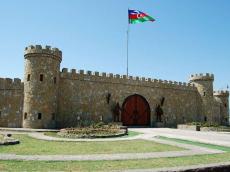|
|
TODAY.AZ / Arts & Entertainment
UNESCO includes Lankaran into list of creative cities
10 November 2021 [10:18] - TODAY.AZ

By Azernews
By Laman Ismayilova
Famous for its gastronomy, Lankaran region has been included in the UNESCO list "Network of Creative Cities."
In this regard, the Azerbaijan Culture Ministry sent a candidate document to the UNESCO Secretariat.
Founded in 2004, Network of Creative Cities unites cities based on creativity and considers innovations and creativity as a key factor in order to promote sustainable urban development.
Around 49 cities joined UNESCO's Network of Creative Cities in decision of the Director-General of UNESCO Audrey Azul.
The network includes a total of 295 cities in 90 countries that invest in culture and art. It covers seven creative fields: Crafts and Folk Arts, Media Arts, Film, Design, Gastronomy, Literature and Music.
Meanwhile, Baku is a member of the Network of Creative Cities since 2019 for "design", and Shaki since 2017 – on "art and crafts".
Azerbaijan's south-eastern region is blessed with subtropical crops, such as tea and citrus. Lankaran is a fruit lover's paradise with a multitude of delicious fruits.
If you visit Azerbaijan, the Land of Fire, you should definitely taste its tea. Lankaran is well-known throughout Azerbaijan for producing the best tea in the country. The subtropical climate of the region is ideal for its growing.
The first tea plantations appeared here in 1896. In 1937, the first packs of Azerbaijani tea were released. In Soviet times, Azerbaijani tea was very popular.
Lankaran is also is famous for its rich and delicious cuisine. Lavangi, Lankaran kulcha, marji plov, white plov, pumpkin plov and turshu kebab are the best examples of local cuisine.
Unique landscapes, wonderful sceneries, historical attractions and great climate create favorable conditions for tourism development.
The region is home to numerous historical sites Lankaran fortress (18th century) and Kichik-Bazar mosque (19th century) deserve special attention. In 100 kilometers north of Lankaran, there is Khanega village of the Middle Ages, where one can find such historical monuments of architecture as the fortress walls (12-14 centuries), the mosque and the tomb of Pir-Hussein, Mirakhmad Khan's Palace and some other ancient buildings.
URL: http://www.today.az/news/entertainment/212000.html
 Print version
Print version
Connect with us. Get latest news and updates.
See Also
- 14 February 2025 [15:38]
Azerbaijani books donated to Turkiye's Rami Library - 14 February 2025 [13:28]
Forget about roses: NASA offers gift of truly cosmic proportions on Valentine's Day - 14 February 2025 [12:19]
akart continues promoting Azerbaijan’s cultural heritage - 14 February 2025 [10:45]
ArtVerg: Film "Woman in Gold" screened in Baku - 13 February 2025 [15:22]
Baku to host memorial evening for renowned mugham singer - 13 February 2025 [13:36]
People's Artist Rufat Khalilzade offers insights on dance art - 12 February 2025 [15:05]
Film-Makers Union launches full-length feature script competition - 12 February 2025 [10:24]
ANAS announces plan of events to mark 100th anniversary of Elm Publishing House - 11 February 2025 [13:03]
State Symphony Orchestra gives spectacular concert in Baku - 11 February 2025 [12:06]
Cultural scientists discuss country's socio-cultural development
Most Popular
 Foreign Ministers of China, South Korea and Japan hold meeting in Tokyo
Foreign Ministers of China, South Korea and Japan hold meeting in Tokyo
 Istanbul Airport witnesses growth in number of passenger & cargo traffic
Istanbul Airport witnesses growth in number of passenger & cargo traffic
 MÜS?AD outlines strategic steps for economic resilience
MÜS?AD outlines strategic steps for economic resilience
 The Trans-Caspian route in the mirror of Azerbaijani-Chinese relations
The Trans-Caspian route in the mirror of Azerbaijani-Chinese relations
 Armenians begged Snoop Dogg for budget money
Armenians begged Snoop Dogg for budget money
 Azerbaijan files arbitration claim against Armenia over environmental destruction
Azerbaijan files arbitration claim against Armenia over environmental destruction
 Alain vs Samvel: Circus on the wreckage of the "struggle"
Alain vs Samvel: Circus on the wreckage of the "struggle"
